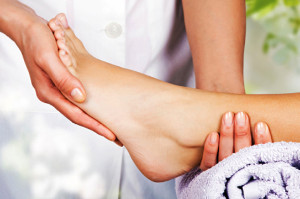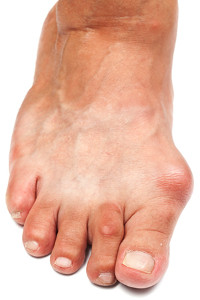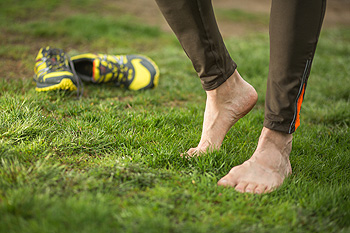Items filtered by date: May 2019
Possible Causes and Symptoms of an Achilles Tendon Injury
 The Achilles tendon is the largest tendon in the body. It is located in the back of the leg, and its function is to connect the foot to the leg muscles. The injury that is known as Achilles Tendinitis often occurs as a result of small tears that can negatively affect the strength of the tendon. There are several reasons why this injury occurs. These may include running on uneven surfaces, having weak or tight calf muscles, or a sudden increase in activity level. A common symptom that is associated with this condition is typically pain and discomfort in the back of the leg, especially in the morning hours. Additionally, that area of the leg may be swollen, it is possible to notice a decrease in strength. If you have an Achilles tendon injury, it is suggested to rest the foot, and consult with a podiatrist as quickly as possible who can guide you toward beginning the proper treatment.
The Achilles tendon is the largest tendon in the body. It is located in the back of the leg, and its function is to connect the foot to the leg muscles. The injury that is known as Achilles Tendinitis often occurs as a result of small tears that can negatively affect the strength of the tendon. There are several reasons why this injury occurs. These may include running on uneven surfaces, having weak or tight calf muscles, or a sudden increase in activity level. A common symptom that is associated with this condition is typically pain and discomfort in the back of the leg, especially in the morning hours. Additionally, that area of the leg may be swollen, it is possible to notice a decrease in strength. If you have an Achilles tendon injury, it is suggested to rest the foot, and consult with a podiatrist as quickly as possible who can guide you toward beginning the proper treatment.
Achilles tendon injuries need immediate attention to avoid future complications. If you have any concerns, contact Dr. Joshua David Scoll of Pennsylvania. Our doctor can provide the care you need to keep you pain-free and on your feet.
What Is the Achilles Tendon?
The Achilles tendon is a tendon that connects the lower leg muscles and calf to the heel of the foot. It is the strongest tendon in the human body and is essential for making movement possible. Because this tendon is such an integral part of the body, any injuries to it can create immense difficulties and should immediately be presented to a doctor.
What Are the Symptoms of an Achilles Tendon Injury?
There are various types of injuries that can affect the Achilles tendon. The two most common injuries are Achilles tendinitis and ruptures of the tendon.
Achilles Tendinitis Symptoms
- Inflammation
- Dull to severe pain
- Increased blood flow to the tendon
- Thickening of the tendon
Rupture Symptoms
- Extreme pain and swelling in the foot
- Total immobility
Treatment and Prevention
Achilles tendon injuries are diagnosed by a thorough physical evaluation, which can include an MRI. Treatment involves rest, physical therapy, and in some cases, surgery. However, various preventative measures can be taken to avoid these injuries, such as:
- Thorough stretching of the tendon before and after exercise
- Strengthening exercises like calf raises, squats, leg curls, leg extensions, leg raises, lunges, and leg presses
If you have any questions please feel free to contact one of our offices located in Philadelphia, Bensalem, and Fairless Hills, PA . We offer the newest diagnostic tools and technology to treat your foot and ankle needs.
Types of Running Injuries
Research has indicated that many runners get injured every year. Running injuries can be prevented when properly fitted shoes are worn, and stretching techniques are implemented. A common injury is referred to as Achilles tendinitis, which is typically caused by tight calf muscles. The Achilles tendon can be strengthened by performing heel raises several times before running. If you have plantar fasciitis, you are most likely familiar with the pain that exists in the heel of the foot. Mild relief may be found when the plantar fascia is properly stretched. This is accomplished by pulling your toes gently away from your foot, in addition to rolling the bottom of your foot on a frozen water bottle or tennis ball. If you would like more information about how to prevent running injuries, it is suggested that you counsel with a podiatrist.
Exercising your feet regularly with the proper foot wear is a great way to prevent injuries. If you have any concerns about your feet, contact Dr. Joshua David Scoll of Pennsylvania. Our doctor will treat your foot and ankle needs.
How to Prevent Running Injuries
Many common running injuries are caused by overuse and overtraining. When the back of the kneecap starts wearing out and starts causing pain in your knee, this is commonly referred to as runner’s knee. Runner’s knee is a decrease in strength in your quadriceps and can occur if you’re not wearing properly fitted or supporting shoes. To prevent runner’s knee, focusing on hip strengthening is a good idea, as well as strengthening your quads to keep the kneecaps aligned.
What Are Some Causes of Running Injuries?
- One cause of a common running injury is called iliotibial band syndrome.
- Plantar fasciitis is also another common injury.
- Stress fractures can occur from overtraining, lack of calcium, or even your running style.
Best Ways to Prevent Running Injuries
- Wear footwear that fits properly and suits your running needs.
- Running shoes are the only protective gear that runners have to safeguard them from injury.
- Make a training schedule. Adding strengthening exercises as well as regular stretching can help keep you strong and limber and can lessen the possibility of injuries.
- Stretching keeps muscles limber; this will help you gain better flexibility.
If you have any questions please feel free to contact one of our offices located in Philadelphia, Bensalem, and Fairless Hills, PA . We offer the newest diagnostic and treatment technologies for all your foot and ankle needs.
Types of Foot Therapy
 Patients who have foot pain can benefit from different types of foot therapy. When the feet are soaked in warm water, mild relief may be found. This is helpful in relaxing sore foot muscles. Additionally, having foot massages performed can aid in reducing tension in the body, improving circulation, and may ease any pain that is present. When the toes are spread apart, the muscles that lie underneath are stretched, and this may help to strengthen the entire foot. There are some patients who find it beneficial to use topical treatments which include eucalyptus oil.This provides a different sensation, and may help in relieving existing foot pain. If you would like to learn of additional types of foot therapy, it is advised to schedule a consultation with a podiatrist who can properly guide you.
Patients who have foot pain can benefit from different types of foot therapy. When the feet are soaked in warm water, mild relief may be found. This is helpful in relaxing sore foot muscles. Additionally, having foot massages performed can aid in reducing tension in the body, improving circulation, and may ease any pain that is present. When the toes are spread apart, the muscles that lie underneath are stretched, and this may help to strengthen the entire foot. There are some patients who find it beneficial to use topical treatments which include eucalyptus oil.This provides a different sensation, and may help in relieving existing foot pain. If you would like to learn of additional types of foot therapy, it is advised to schedule a consultation with a podiatrist who can properly guide you.
Foot therapy is often necessary for those recovering from either foot deformities or foot injuries. If you have concerns regarding therapy, consult with Dr. Joshua David Scoll from Pennsylvania. Our doctor can provide the care you need to keep you pain-free and on your feet.
Most Common Injuries
People who are active or athletes are prone to a variety of injuries. Therefore, it is often important to take part in physical therapy in order to quickly get back on the right track.
What to Do When Injured
Physical Therapy – This specialized treatment will focus on the affected area, speeding up recovery and the overall healing process. It is a proven method that has helped millions of people return from any injury.
During physical therapy you will undergo regimented training to get back into full form. Training is often very difficult, especially at first when the foot feels weak. Physical therapy often involves:
Basic stretching and twisting exercises – getting the feet’s mobility and flexibility up.
Massaging – the therapist will massage the injured area in order to activate the muscles and relax them.
Strengthening Exercises – this allows the muscles in the affected area to regain their full strength, a vital step towards full recovery.
If you have any questions please feel free to contact one of our offices located in Philadelphia, Bensalem, and Fairless Hills, PA . We offer the newest diagnostic tools and technology to treat your foot and ankle needs.
Wearing Correct Shoes Are Helpful in Preventing Bunions
 A bone that extends on the side of the big toe is referred to as a bunion. A common reason for this condition to develop can come from wearing shoes that do not provide adequate room for the toes to move freely in. The toes may shift, and one toe may overlap the other. The toes have limited space to move around in, and this may result in cramping. There are other factors that can contribute to the development of bunions, which includes genetics or arthritis. Mild relief may be found when the correct size shoes are worn, and this is helpful in preventing pressure that is put on the bunion. When this condition exists, a diagnosis is performed, which includes having an X-ray, MRI, or ultrasound taken. If you have developed a bunion, it is strongly suggested that you seek the counsel of a podiatrist who can properly treat this ailment.
A bone that extends on the side of the big toe is referred to as a bunion. A common reason for this condition to develop can come from wearing shoes that do not provide adequate room for the toes to move freely in. The toes may shift, and one toe may overlap the other. The toes have limited space to move around in, and this may result in cramping. There are other factors that can contribute to the development of bunions, which includes genetics or arthritis. Mild relief may be found when the correct size shoes are worn, and this is helpful in preventing pressure that is put on the bunion. When this condition exists, a diagnosis is performed, which includes having an X-ray, MRI, or ultrasound taken. If you have developed a bunion, it is strongly suggested that you seek the counsel of a podiatrist who can properly treat this ailment.
If you are suffering from bunions, contact Dr. Joshua David Scoll of Pennsylvania. Our doctor can provide the care you need to keep you pain-free and on your feet.
What Is a Bunion?
A bunion is formed of swollen tissue or an enlargement of boney growth, usually located at the base joint of the toe that connects to the foot. The swelling occurs due to the bones in the big toe shifting inward, which impacts the other toes of the foot. This causes the area around the base of the big toe to become inflamed and painful.
Why Do Bunions Form?
Genetics – Susceptibility to bunions are often hereditary
Stress on the feet – Poorly fitted and uncomfortable footwear that places stress on feet, such as heels, can worsen existing bunions
How Are Bunions Diagnosed?
Doctors often perform two tests – blood tests and x-rays – when trying to diagnose bunions, especially in the early stages of development. Blood tests help determine if the foot pain is being caused by something else, such as arthritis, while x-rays provide a clear picture of your bone structure to your doctor.
How Are Bunions Treated?
- Refrain from wearing heels or similar shoes that cause discomfort
- Select wider shoes that can provide more comfort and reduce pain
- Anti-inflammatory and pain management drugs
- Orthotics or foot inserts
- Surgery
If you have any questions, please feel free to contact one of our offices located in Philadelphia, Bensalem, and Fairless Hills, PA . We offer the newest diagnostic and treatment technologies for all your foot care needs.


